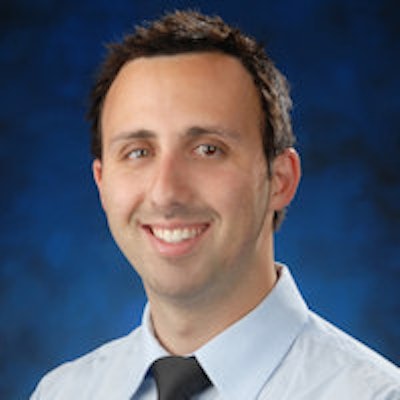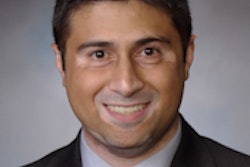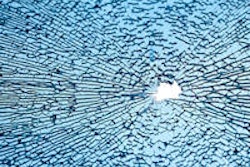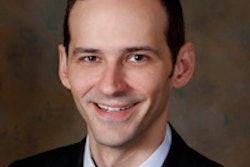
Radiologists are coming around to the idea that they need to get out of the reading room and in front of patients and referring physicians to improve their visibility. California researchers described their efforts to do just that in a new study published in the Journal of the American College of Radiology.
Researchers from the University of California, Irvine (UCI) wanted to find out what would happen if they sent a senior radiology resident on rounds with internal medicine teams -- discussing exams, consulting on the way forward, and answering questions about imaging appropriateness and protocols. According to the results of a survey collected at the end of the project, most clinicians were more than happy with the results -- and some patients even learned what a radiologist is.
"We rounded with a team for a couple weeks and acted as a real-time consultant with an iPad or a laptop, and went over the imaging and even showed patients their imaging," said lead author Dr. Mark Mamlouk, who completed the project as a fourth-year resident at UCI and recently joined the University of California, San Francisco as a fellow. "It turned out to be a great success."
Combating commoditization
The specter of imaging commoditization was top of mind as the team looked for practices that might help keep radiology relevant in a new era, he said. Thanks to research and technological development, the field of radiology would do just fine, the group thought, but the future of radiologists was still up for grabs.
"Declining reimbursements, longer hours, and busier shifts are the new norm and are likely here to stay, if not get worse," wrote Mamlouk and his UCI colleagues Dr. Arash Anavim and Dr. Scott Goodwin. "Although we have all felt the impact of these changes, they pale in comparison with the process of commoditization" (JACR, July 11, 2013).
This sobering reality has led to new questions, such as "What matters more: the radiologist or the radiology report?" they wrote. "Is the radiologist simply a name on a report, without a face or identity? Has the radiology report become equivalent to a complete blood count in the clinician's eyes? These questions, which may seem flippant, pose real dangers that need to be faced."
 Dr. Mark Mamlouk.
Dr. Mark Mamlouk.
Face them the researchers did, with a plan to address what they considered the chief element in radiologists' declining invisibility: lack of communication with other clinicians. In the PACS era, more and more are reading their own studies, as radiologists cut down on time spent educating other physicians in an effort to keep up with their fast-growing workflow.
The pilot study put a senior resident (Mamlouk) into rounds with several internal medicine teams for a two-week rotation, armed with lists and histories for each patient. During the rounds, the resident would get to know the doctors and the patients, highlighting important images, answering questions, and discussing patient management.
"After the team presented the patients, I presented imaging of that patient -- anything new, anything coming up," Mamlouk told AuntMinnie.com. "I helped protocol any additional future studies, and we even performed ultrasound at the bedside to look at abscesses or what have you; so I was basically a real-time liaison between the radiology department and the clinical teams. Most patients didn't know what a radiologist was, so I spoke to them and they loved seeing their images in real-time."
At the end of the rotation, the authors asked the clinical team to complete a survey on the project and on the service radiology provides. The survey was completed by three medical students, 12 residents, and five faculty members.
The verdict
The clinicians were asked if the rounds had improved their knowledge of radiology. Half agreed, while the other half strongly agreed. The teams were asked if the rounds had improved their ability to protocol exams. Here 50% agreed, 15% strongly agreed, and 35% neither agreed nor disagreed.
They were asked if they felt that a strong clinician-radiologist relationship improves patient care: 90% strongly agreed, and the other 10% agreed.
Another survey question asked clinicians, "Would you liken the radiologist's report to a lab test where it doesn't matter who interprets your patient's imaging exams?" Here 42% disagreed with the notion and 16% strongly disagreed. But 32% neither agreed nor disagreed, and 10% agreed with the idea that the reader doesn't matter.
When asked if they'd like to see radiologists on future clinical rounds, 95% strongly agreed and 5% agreed.
The aftermath
After the experience, Mamlouk said his consulting skills had improved, and he better appreciated the clinicians' perspectives, as well as the precise information they needed most. Meanwhile, the clinicians "thoroughly enjoyed" the experience, the authors wrote. "They claimed the radiology resident streamlined patient care, helped avoid ordering unnecessary studies, and increased their knowledge of radiology," the authors wrote.
Some of the most important things the clinicians learned were the finer points of follow-up studies -- whether more imaging is needed and what kind, contrast or noncontrast, etc., Mamlouk said.
Patients also became increasingly familiar with the functions of a radiologist, telling the medical team that they welcomed having a radiologist as part of their clinical care. Before the experiment, most patients didn't even know what a radiologist was.
"So I spoke to them and they loved seeing their images in real-time," Mamlouk said. "Most of them had some concept of a radiologist, but they think you're a tech -- a behind-the-scenes person reading the images. A lot of times they think it's a clinician reading the images, or an internist."
While the majority of respondents said they wouldn't liken the radiology report to a lab test, those who were neutral or felt that the reader doesn't matter suggest that commoditization is a real factor.
In any case, Mamlouk said he is convinced that more consulting, whenever possible, could improve patient care and maybe even help save the radiologist from extinction by keeping the specialty relevant to patient care. Incorporating consulting into the educational curriculum of all doctors is the way to make it happen, he said.
"It's an important process for trainees to undergo so they can learn to be better consultants," Mamlouk said. "I think that out in the real world you have this fear of commoditization, but what you've been doing is just cranking out more studies and trying to work harder to boost your [relative value units (RVUs)]. But then you risk losing your business and your clinicians."
"So if we can develop this education for trainees and say that you need to take care of your consultants and interact with clinicians, it will provide the stepping stones to becoming a good radiology consultant," he continued. "Then, out in the real world when you're past training, you can dedicate maybe two hours a week to consulting."
Rounding with clinical teams doesn't ever need to be a full-time job, and for some busy practices it could be impossible to do regularly, he acknowledged. But if every resident were to incorporate rounds for two to four weeks out of a four-year residency, it could make the difference between a clinician "sending his business to you or the other guy," Mamlouk said.



















